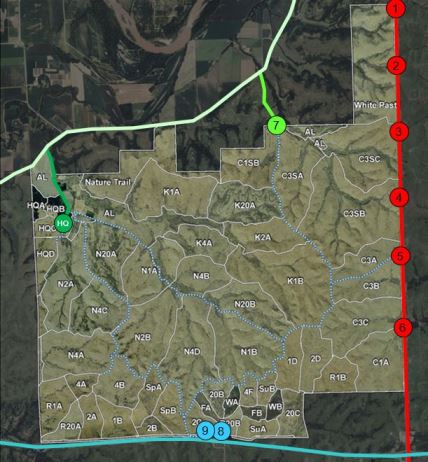Rules for Site Use
Please read these RULES FOR SITE USE before beginning research at KPBS and review them annually as you begin your fieldwork. Senior project leaders are responsible for communicating these rules to all project participants. Here is a printable pdf of this page: rules.pdf
SMOKING - The prairie is extremely vulnerable to fire. SMOKING ANYWHERE ON THE SITE (INCLUDING IN BUILDINGS) IS STRICTLY PROHIBITED.
EMERGENCIES/WILDFIRES - A CODE ORANGE SYSTEM is employed to deal with accidental fires or other emergencies on Konza. To activate the CODE ORANGE SYSTEM call:
| Contact | Work Phone | Cell Phone |
Patrick O'Neal | 785-539-1961 | 785-477-2347 |
Peyton Thorell | 785-539-1961 | 785-656-2810 |
John Blair | 785-532-7065 | 785-341-4663 |
If you spot a fire, and none of the above can be reached, call 911. Use the headquarters map for emergency addresses.
VEHICLE USE ON KONZA - Effects of vehicles on vegetation and soil can be substantial and persist for years. Therefore, vehicles should be used judiciously and as little as possible in the restricted areas of KPBS (i.e., through locked gates). If possible, drive only on the gravel roads. Mowed and clearly marked fireguards may be driven on when required, but only if conditions are dry and steep slopes are avoided. Vehicle use off fireguards or trails is prohibited. SPEED LIMIT IS 15 MPH, or slower when conditions require it (wet soil, curves, steep hills, etc.). When turning around on a road or trail, DO NOT MAKE A CIRCLE TURN through the prairie. Make a three-point turn by driving and backing short distances across the trail, so that the vehicle goes NO MORE THAN 2 METERS off the trail or fireguard.
FOOT TRAFFIC - is restricted to trails and fireguards unless the researcher has discussed establishment of potential study sites and is fully aware of the work of other researchers in the area.
BISON - Bison are DANGEROUS animals. Exercise extreme caution when inside the bison area. Bison are curious and will often approach and surround a vehicle. If this happens, REMAIN INSIDE. If on foot, keep alert to the animals' location and movements, and the possibility that the herd may be split into several groups. Bison appear harmless, but are powerful and extremely quick. Never turn your back on a bison as this may be taken as an invitation to charge.

EQUIPMENT & MARKERS (flags, stakes, etc.) - should be labeled with the investigator's name or initials. Avoid placing markers or equipment on fireguards or within 5 meters of a trail or fireguard, as this interferes with mowing operations. RESEARCHERS ARE RESPONSIBLE FOR BEING AWARE OF BURNING SCHEDULES SO THAT MATERIALS WHICH WOULD BE DAMAGED ARE REMOVED OR PROTECTED. All markers and equipment must be removed at the end of their use.
COLLECTIONof biota, rocks, fossils, or other materials for other than research purposes is prohibited. Research collections must be detailed in a research agreement form and approved prior to collection.
ARCHAEOLOGICAL REMAINS - No individual will remove possible archaeological remains (either prehistoric, historic or contemporary) from KPBS; when in doubt leave it in place. This is done both for ethical purposes (out of respect of past peoples) and for research value. Archaeological artifacts should not be removed, but should be reported to the Director and a professional archaeologist (e.g., Dr. Lauren W. Ritterbush, lritterb@ksu.edu, or Dr. Brad Logan, blogan@ksu.edu, KSU archaeologists familiar with the KPBS and regional archaeology). If an extreme situation exists when an artifact must be removed (for instance, that it or its context will be destroyed), its location should be documented as thoroughly and precisely as possible. For instance, take a GPS reading and draw and describe exactly where and how the object was found, then immediately report all this to a professional archaeologist. Please keep in mind, that whenever an artifact is removed from the context in which it was originally deposited, scientists lose much potential information about that object and, importantly, the people who made it.
INTRODUCTION of exotic organisms, non-local genotypes of native species, chemicals, or other materials is prohibited. If trash is found on Konza Prairie, please carry it out and deposit in the trash bin near the Headquarters.
AMENDED USER PERMITS - An amended research agreement form must be filed if your project is changed to employ additional samples or sampling procedures, or take place in areas that were not approved in the original User Permit Application.
PROJECT COMPLETION AND REPORTING REQUIREMENTS - At the end of each project, investigators are required to remove any remaining equipment, flags, site markers, etc. and return the study site to its original condition. Citations of any thesis, dissertations, or publications resulting from research done in whole or in part at KPBS should be provided to the KPBS Director for inclusion in the KPBS publication database. Graduate students using KPBS facilities or materials should provide an electronic link or copy of their thesis or dissertation with the KPBS Office. Use of KPBS facilities or data should be acknowledged in seminars, publications, reports, dissertations, or theses in a format such as "Konza Prairie Biological Station is a preserve of The Nature Conservancy managed by the Division of Biology at Kansas State University". Information on the location and storage characteristics of your original data may also be requested. Any arrangements for deposit of preserved specimens of biota or other materials should be made as part of the research application.
SEMINARS AND PUBLICATIONS - Please acknowledge KPBS in seminars and publications in a format such as "Konza Prairie Biological Station is a preserve of The Nature Conservancy managed by the Division of Biology at Kansas State University".
VANDALISM - Pleasenotify the Konza Prairie Office (587-0441) or the Site Manager (539-1961) if you observe instances of abuse, vandalism, stray animals, trespassers, damage to fences, or other problems.
